Numerical Simulation of Ultra-Shallow Buried Large-Span Double-Arch Tunnel Excavated under an Expressway
Abstract
1. Introduction
2. Overview of the Engineering
3. Numerical Model
3.1. Establishment of Numerical Model
3.2. Material Parameters
4. Numerical Results and Discussion
4.1. Numerical Model Accuracy Verification
4.2. Analysis of Numerical Simulation Results of Pilot Tunnel Excavation
4.2.1. Deformation Analysis of Surface and Surrounding Rock
4.2.2. Lining Deformation Analysis
4.2.3. Deformation Analysis of Supporting Structure
4.3. Analysis of Numerical Simulation Results of Main Tunnel Excavation
4.3.1. Deformation Analysis of Surface and Surrounding Rock
4.3.2. Lining Deformation Analysis
4.3.3. Deformation Analysis of the Middle Partition Wall
4.3.4. Deformation Analysis of Underground Pipelines
5. Conclusions
- (1)
- When the tunnel was excavated to the fault fracture zone, the maximum vertical deformation of the surface, surrounding rock and vault increased suddenly, and the horizontal displacement of rock and soil around the pilot tunnel increased obviously. When crossing the distribution area of the fault fracture zone, the excavation footage should be reduced, and the primary support should be applied as soon as possible after the excavation was completed.
- (2)
- The vertical deformation of the lining caused by pilot tunnel excavation was small, indicating that the lining structure design was reasonable.
- (3)
- Among the three pilot tunnels, the vault settlement of the middle pilot tunnel was the largest, and the maximum settlement of the left pilot tunnel and the right pilot tunnel was similar. The rock and soil within 20 m behind the excavation face were greatly disturbed by excavation.
- (4)
- During the excavation of the main tunnel, the horizontal displacement of the central partition wall moved slightly towards the main tunnel excavated first.
- (5)
- During the excavation of the double-arch tunnel, the maximum vertical displacement of the underground pipeline occurred at the position where the central axis of the middle partition wall deviates to the post excavated the main tunnel.
Author Contributions
Funding
Data Availability Statement
Conflicts of Interest
References
- Hwang, J.H.; Kikumoto, M.; Kishida, K.; Kimura, M. Dynamic stability of multi-arch culvert tunnel using 3-D FEM. Tunn. Undergr. Space Technol. 2005, 21, 384. [Google Scholar] [CrossRef]
- Wang, J.; Xia, C.C.; Zhu, H.H.; Li, Y.S.; Lin, Z.L.; Chen, X.J. Site monitoring and analysis of non-symmetrical muti-arch highway tunnel. Chin. J. Rock Mech. Eng. 2004, 23, 267–271. [Google Scholar] [CrossRef]
- Zhou, Z.Q.; Li, S.C.; Li, L.P.; Sui, B.; Shi, S.S.; Zhang, Q.Q. Causes of geological hazards and risk control of collapse in shallow tunnels. Rock. Soil Mech. 2013, 34, 1375–1382. [Google Scholar] [CrossRef]
- Yuan, F.; Liu, X.R.; Zu, L. Optimization of distance between excavation faces of unsymmetrical loaded loess double-arch tunnel. Chin. J. Tunn. Undergr. Space Eng. 2011, 7, 257–262. [Google Scholar] [CrossRef]
- Wu, J.M.; Chen, X.C.; Li, W.Q.; Peng, J.Z.; Zhang, A.L. Forecast of overbreak and analysis of cause of formation in double-arch tunnels in Jinliwen highway. Hydrogeol. Eng. Geol. 2005, 5, 56–59. [Google Scholar] [CrossRef]
- Yan, Q.X.; Zhang, C.; Lin, G.; Wang, B. Field monitoring of deformations and internal forces of surrounding rocks and lining structures in the construction of the gangkou doublearched tunnel—A case study. Appl. Sci. 2017, 7, 169. [Google Scholar] [CrossRef]
- Lai, J.X.; Qiu, J.L.; Fan, H.B.; Chen, J.X.; Hu, Z.N.; Zhang, Q.; Wang, J.B. Structural safety assessment of existing multiarch tunnel: A case study. Adv. Mater. Sci. Eng. 2017, 2017, 1697041. [Google Scholar] [CrossRef]
- Yuan, Y.; Wang, Q.H.; Du, G.P.; Li, D. In-situ testing study on lining system of double-arched tunnel. Chin. J. Rock. Mech. Eng. 2005, 24, 480–484. [Google Scholar] [CrossRef]
- Skrzypkowski, K. Case Studies of Rock Bolt Support Loads and Rock Mass Monitoring for the Room and Pillar Method in the Legnica-Głogów Copper District in Poland. Energies 2020, 13, 2998. [Google Scholar] [CrossRef]
- Zhang, N.; Shen, S.L.; Zhou, A.N.; Lyu, H.M. Challenges of earth-pressure-balance tunnelling in weathered granite with boulders. P. I. Civil. Eng. Geotec. 2020, 174, 372–389. [Google Scholar] [CrossRef]
- Yan, T.; Shen, S.L.; Zhou, A.; Lyu, H.M. Construction efficiency during shield tunnelling through soft deposit in Tianjin, China. Tunn. Undergr. Space Technol. 2021, 112, 103917. [Google Scholar] [CrossRef]
- Li, S.C.; Yuan, C.; Feng, X.D.; Li, S.C. Mechanical behaviour of a large-span double-arch tunnel. KSCE J. Civ. Eng. 2016, 20, 2737–2745. [Google Scholar] [CrossRef]
- Yang, J.S.; Gou, D.M.; Zhang, Y.X. Field measurements and numerical analyses of double-layer pipe roof reinforcement in a shallow multiarch tunnel. Transp. Res. Rec. J. Transp. Res. Board. 2008, 2050, 145–153. [Google Scholar] [CrossRef]
- Liu, C.; Yang, H.; Jiang, X.L.; Shi, H.T. Shaking table test and numerical simulation for acceleration response laws of shallow-buried biased double-arch tunnel. J. Vibroeng. 2019, 21, 1188–1200. [Google Scholar] [CrossRef]
- Liu, T.; Shen, M.R.; Tao, L.B.; He, Z.M.; Yuan, Y. Model test and 3d numerical simulation study on excavation of double-arch tunnel. Chin. J. Rock Mech. Eng. 2006, 25, 1802–1808. [Google Scholar] [CrossRef]
- Liu, X.R.; Liu, J.; Huang, L.H.; Wang, Z.J.; Chen, H.J.; Feng, Y. Model test and pressure arch analysis for excavation of loess double arch tunnel. J. ZheJiang Univ. 2018, 52, 1140–1149. [Google Scholar] [CrossRef]
- Vitali, O.P.M.; Celestino, T.B.; Bobet, A. Analytical solution for tunnels not aligned with geostatic principal stress directions. Tunn. Undergr. Space Technol. 2018, 82, 394–405. [Google Scholar] [CrossRef]
- Hu, X.; Zhang, Z.; Teng, L. An analytical method for internal forces in DOT shield-driven tunnel. Tunn. Undergr. Space Technol. 2009, 24, 675–688. [Google Scholar] [CrossRef]
- Yang, S.; Dai, R.; Ai, Z.B.; Li, X.C.; Zhang, C.; Huang, X. Analytical solutions for the mechanical responses of shallow double-arched tunnel subjected to symmetric loads. Adv. Civ. Eng. 2021, 2021, 8867536. [Google Scholar] [CrossRef]
- Lyu, H.M.; Shen, S.L.; Zhou, A.; Chen, K.L. Calculation of pressure on the shallow-buried twin-tunnel in layered strata. Tunn. Undergr. Space Technol. 2020, 103, 103465. [Google Scholar] [CrossRef]
- Lyu, H.M.; Shen, S.L.; Zhou, A.; Chen, K.L. A novel method to calculate pressure on the twin-tunnel in layered strata. MethodsX 2020, 7 (Suppl. S2), 101126. [Google Scholar] [CrossRef]
- Wu, H.N.; Shen, S.L.; Liao, S.M.; Yin, Z.Y. Longitudinal structural modelling of shield tunnels considering shearing dislocation between segmental rings. Tunn. Undergr. Space Technol. 2015, 50, 317–323. [Google Scholar] [CrossRef]
- Elbaz, K.; Shen, S.L.; Zhou, A.; Yin, Z.Y.; Lyu, H.M. Prediction of disc cutter life during shield tunneling with AI via the incorporation of a genetic algorithm into a GMDH-type neural network. Engineering 2021, 7, 238–251. [Google Scholar] [CrossRef]
- Ahrens, E. Two-and three-dimensional analysis of closely spaced double-tube tunnels. Tunn. Undergr. Space Technol. 1993, 8, 13–18. [Google Scholar] [CrossRef]
- Wang, S.R.; Wang, Y.G.; Li, C.L. Evolution characteristics analysis of pressure—Arch of a highway tunnel under different stress conditions. J. Eng. Sci. Technol. Rev. 2016, 9, 99–105. [Google Scholar] [CrossRef]
- Li, C.L.; Wang, S.R.; Wang, G.Y.; Fang, C.; Fan, Y. Skewed pressure characteristics of equivalent load in double-arch tunnel. J. Eng. Technol. Sci. 2016, 48, 345–358. [Google Scholar] [CrossRef][Green Version]
- Shi, Y.X.; Wang, M.N.; Li, Q. Analysis of influence of blasting vibration on middle wall of a double-arch tunnel. Rock Soil Mech. 2007, 28, 1275–1279. [Google Scholar] [CrossRef]
- Li, D.Y.; Li, X.B.; Zhang, W.; Gong, F.Q.; Huang, B.R. Stability analysis of surrounding rock of multi-arch tunnel based on coupled fluid-solid theorem. Chin. J. Rock Mech. Eng. 2007, 26, 1056–1064. [Google Scholar] [CrossRef]
- Bai, J.S.; Zhao, S.B.; Qi, B.; Yang, K.F. Study on the structure deformation of large-span shallow-buried multi-arch tunnel in soft stratum. Chin. Civ. Eng. J. 2017, 50, 45–50. [Google Scholar] [CrossRef]
- Yang, K.; Dong, F.; Zhang, Y.; Zhang, Z.Y.; Huang, J. Study on the key technology of urban large span double arch tunnel using drilling and blasting method. Technol. Highw. Transp. 2018, 34, 24–32. [Google Scholar] [CrossRef]
- Huang, R.Q.; Xiao, H.B. Deformation mechanism of a shallow double-arch tunnel in a sloping rock mass. Bull. Eng. Geol. Environ. 2009, 69, 89–97. [Google Scholar] [CrossRef]
- Zhang, Z.Q.; He, C. Study on mechanical behaviours of designing and construction for center pillar of double-arched tunnel. Chin. J. Rock Mech. Eng. 2006, 25, 1632–1638. [Google Scholar] [CrossRef]

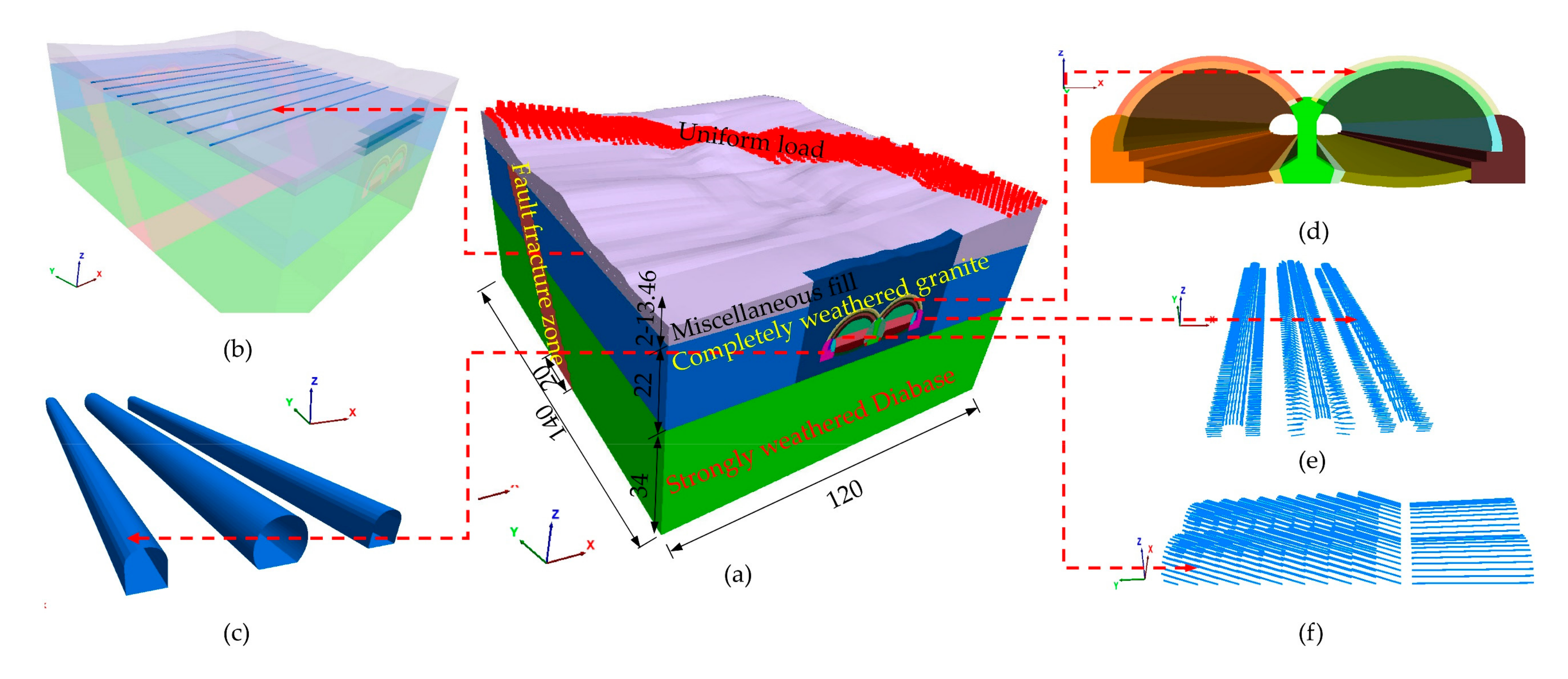
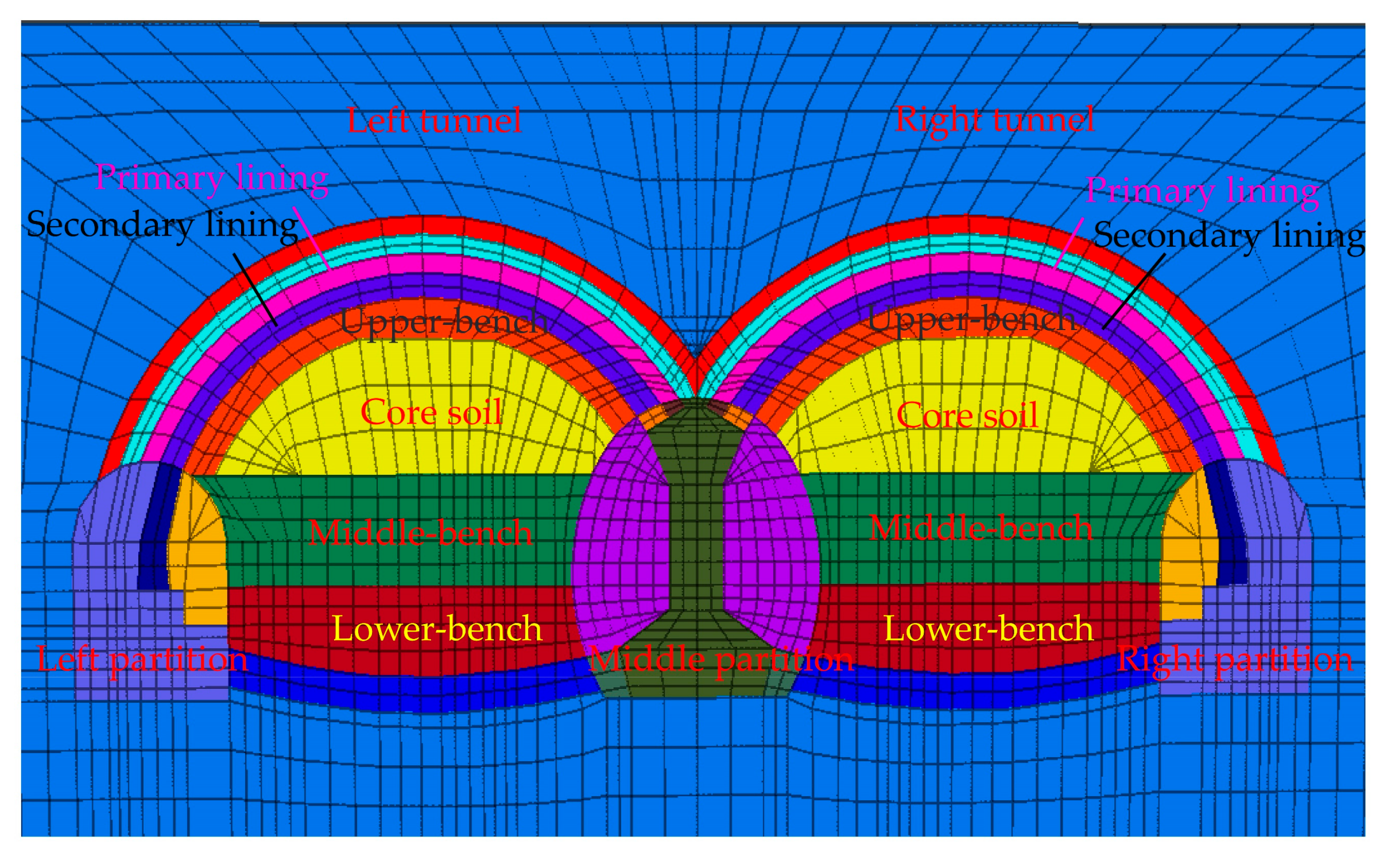



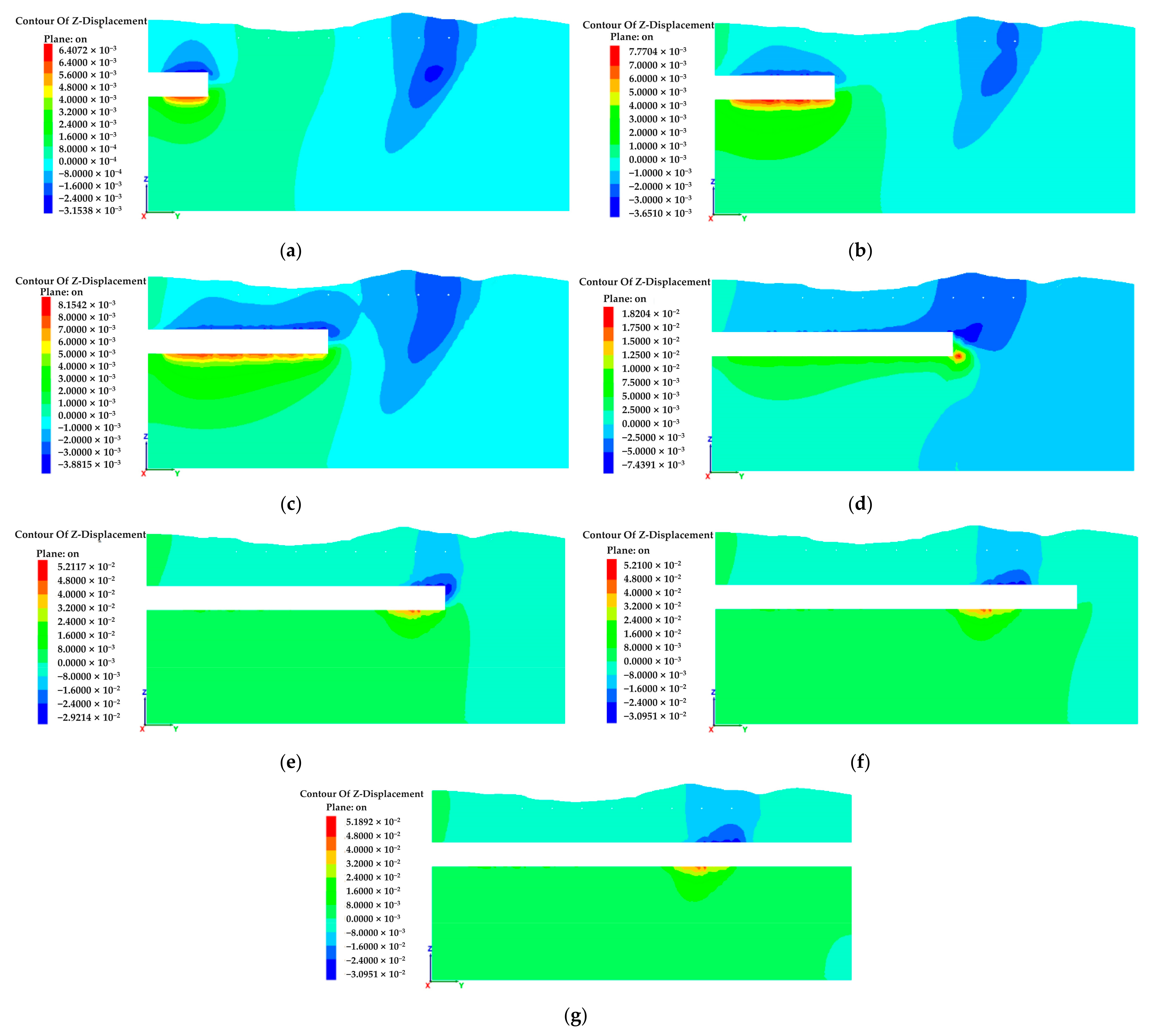

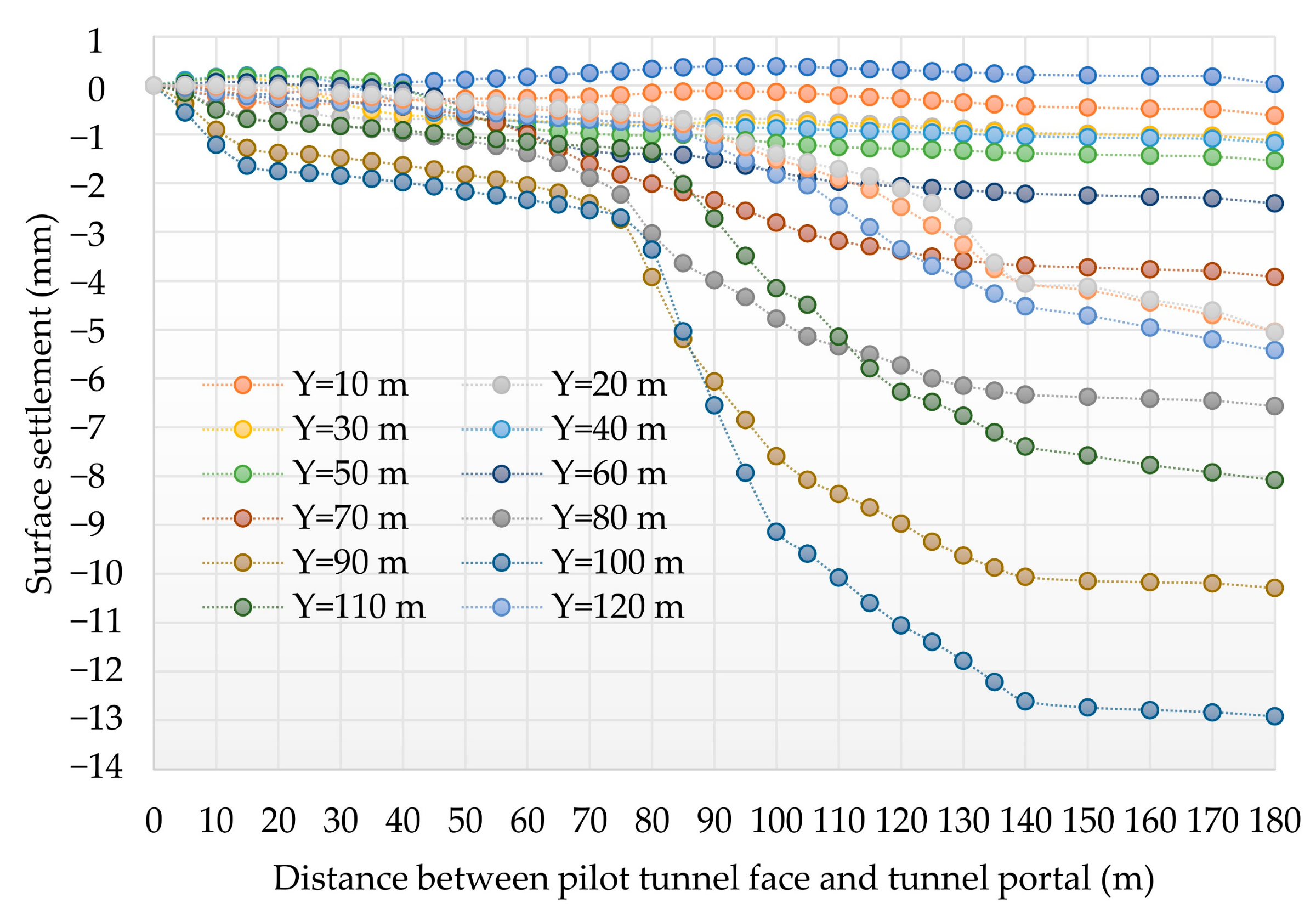
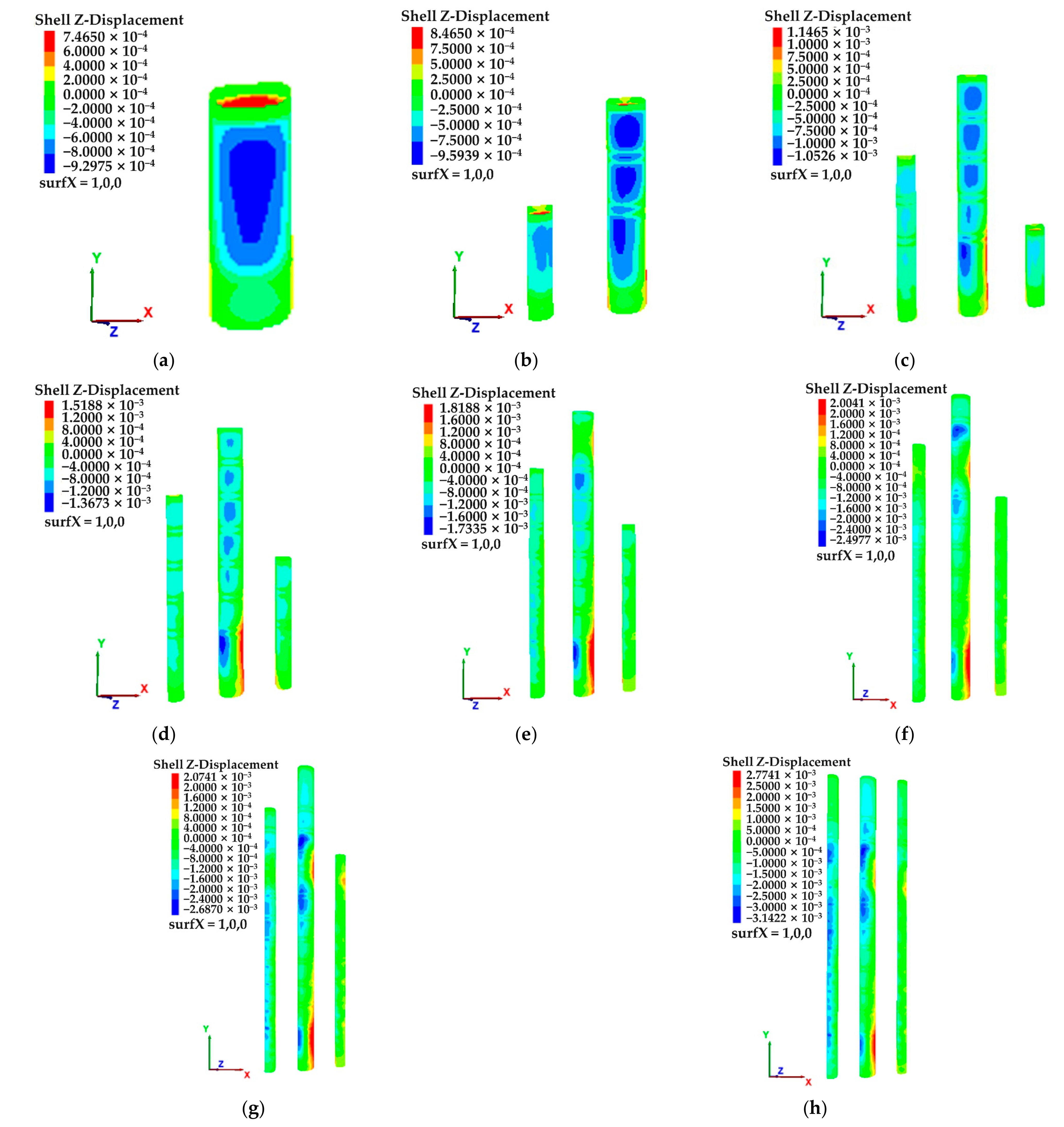



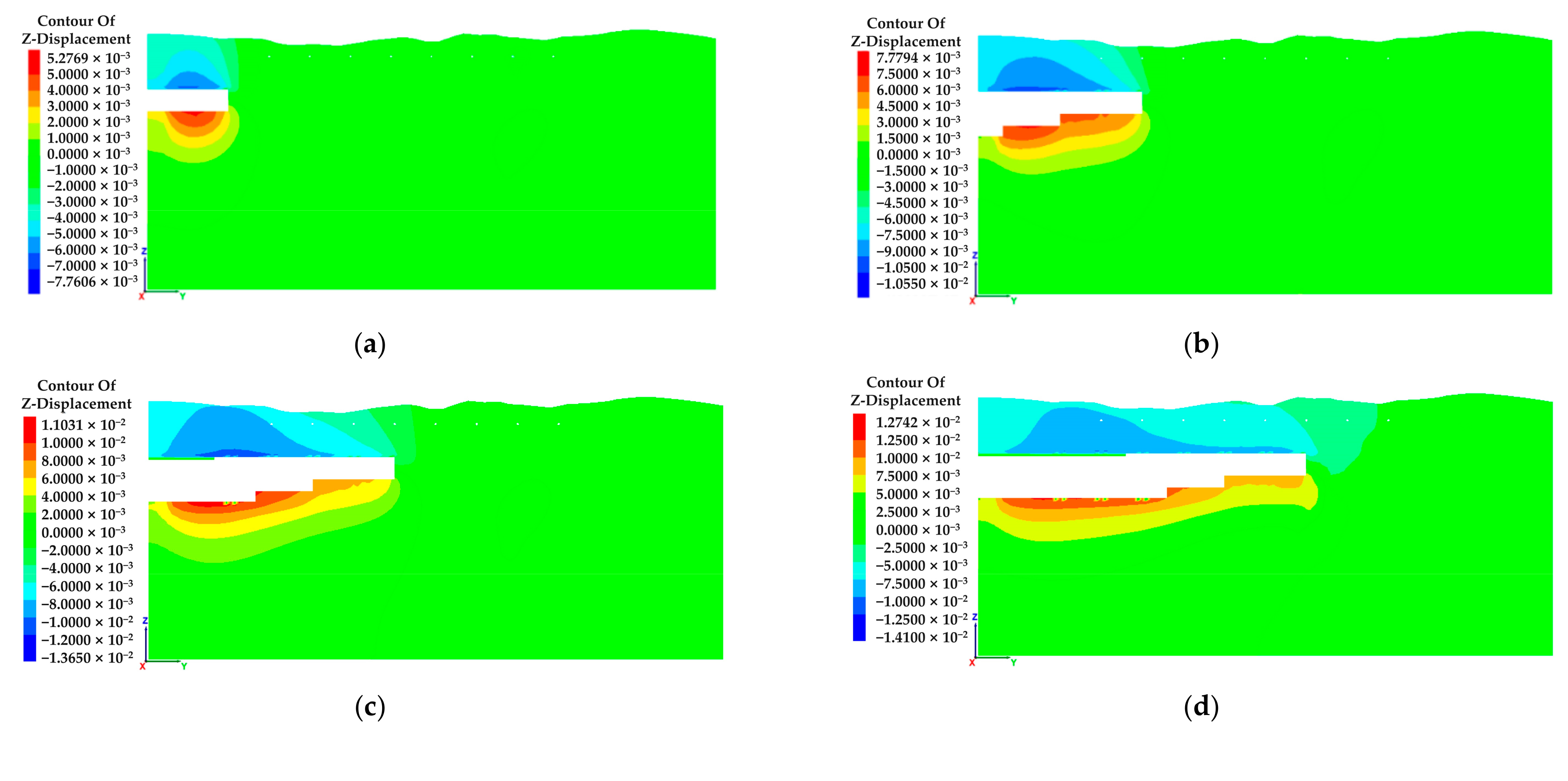
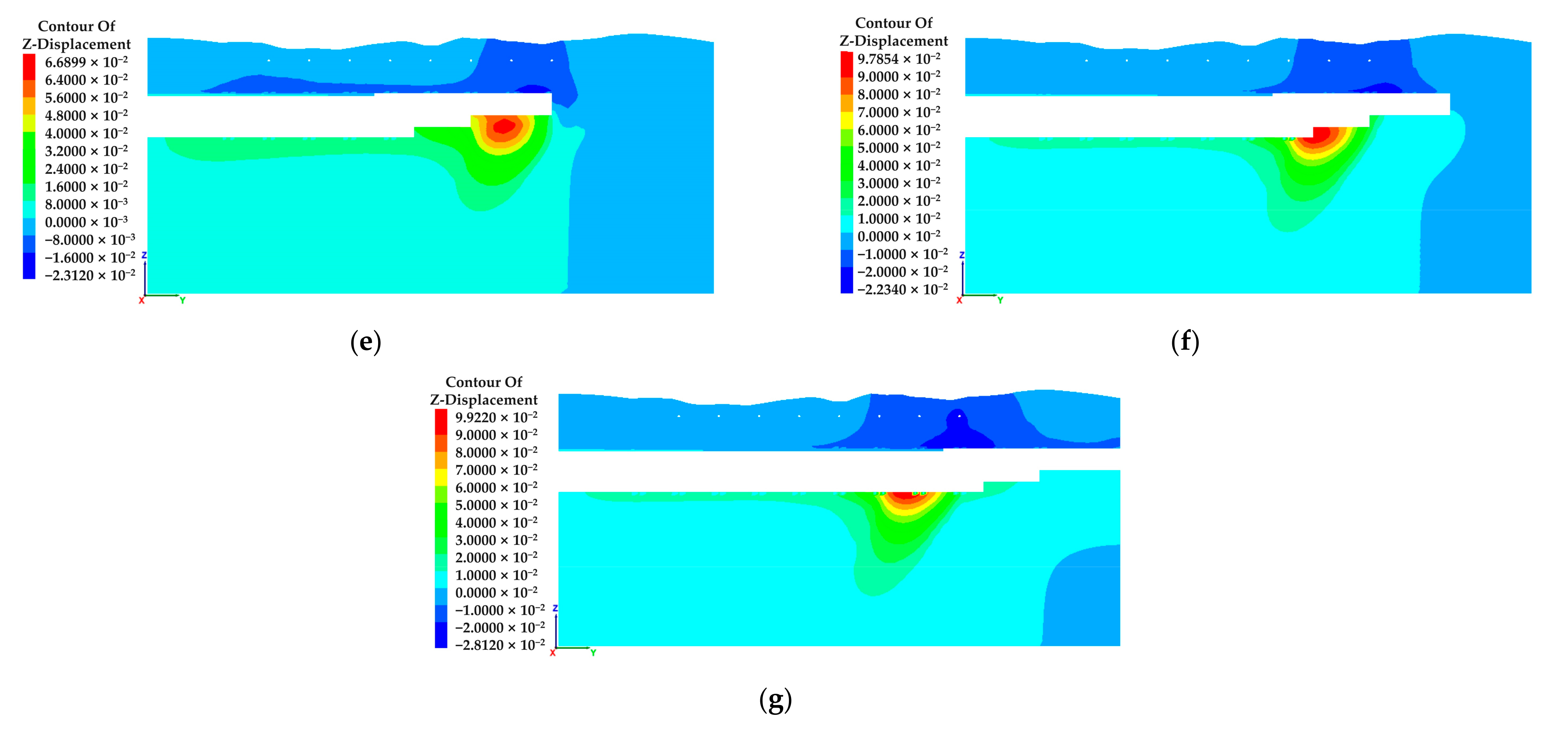

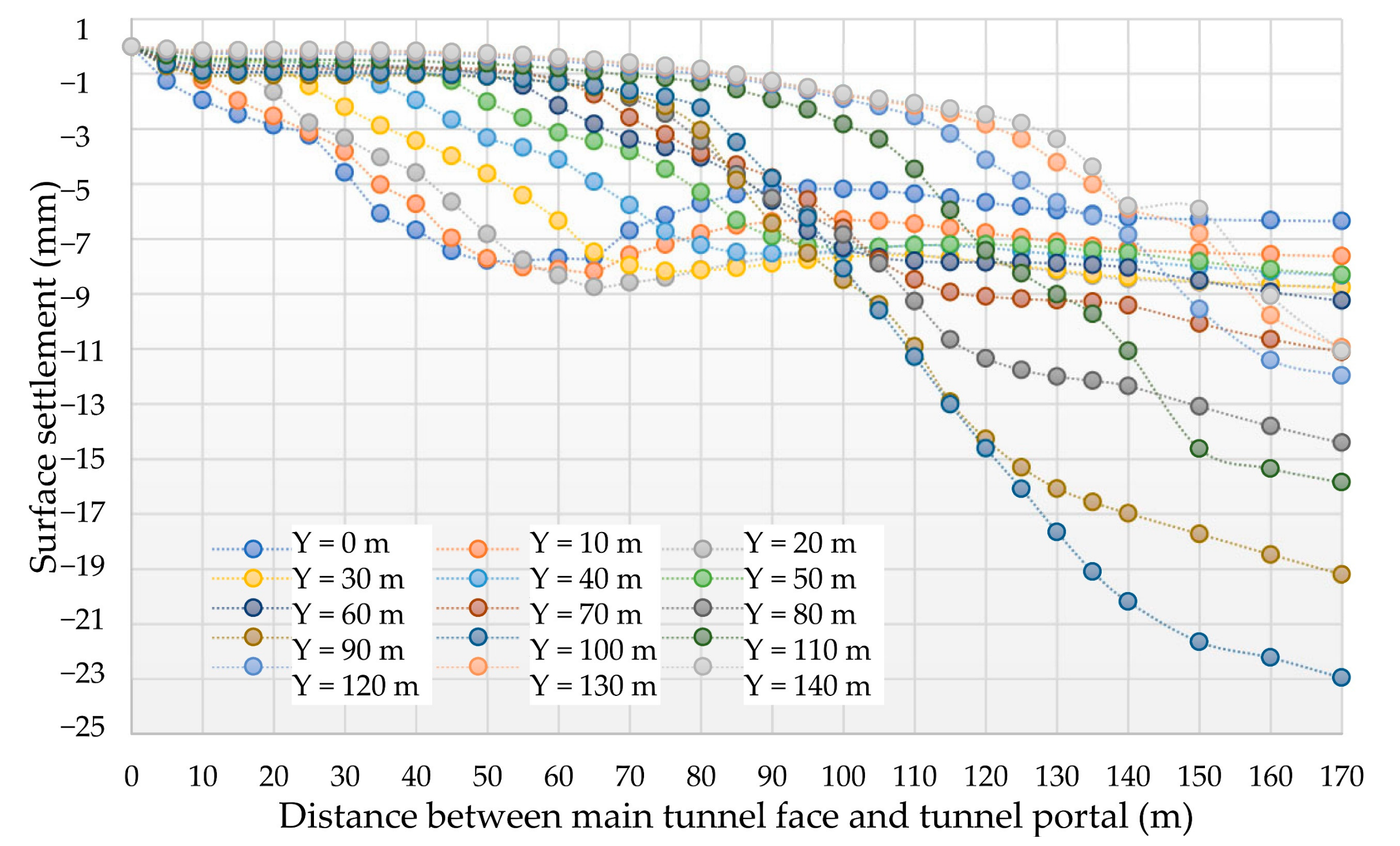
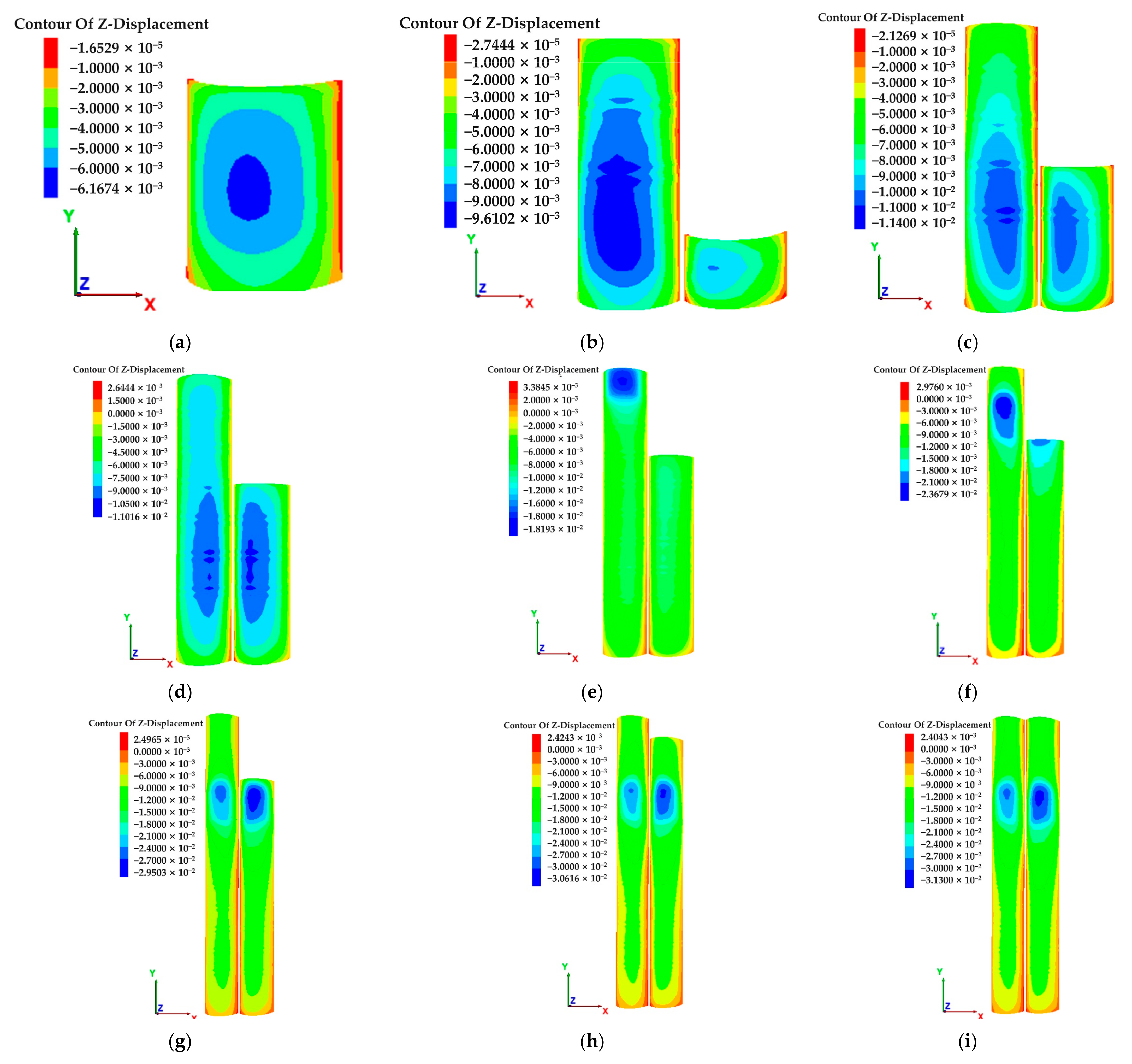

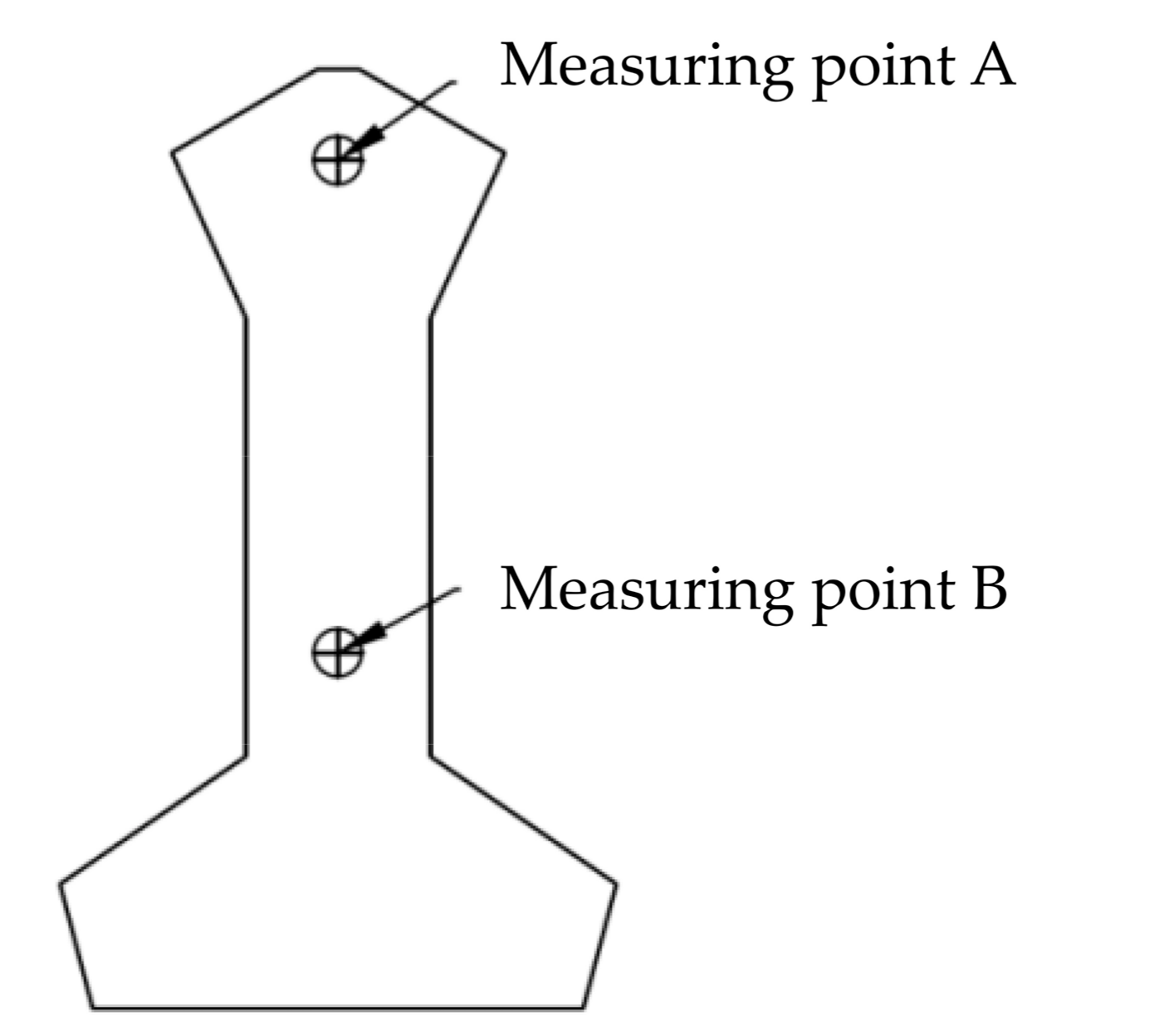

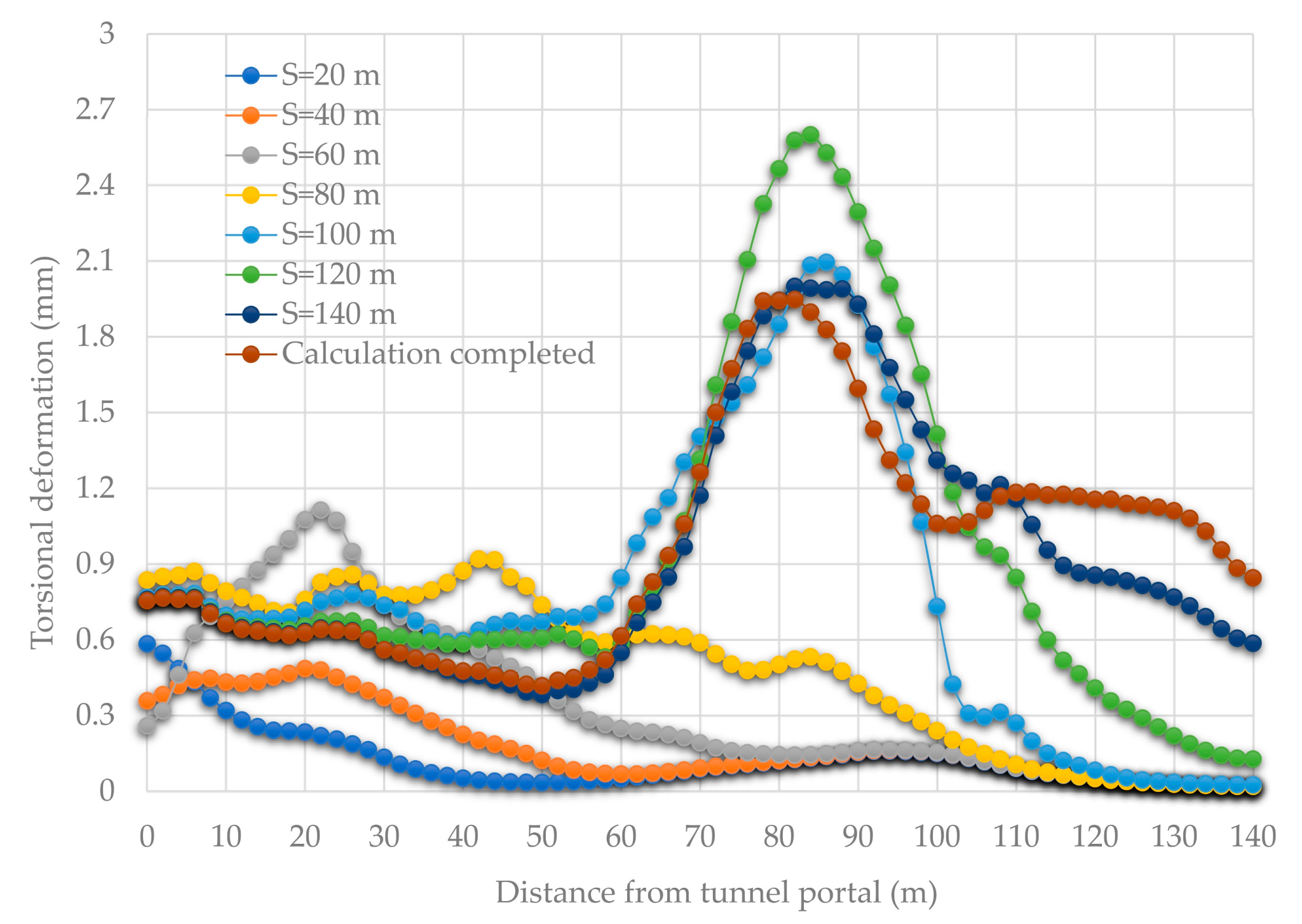
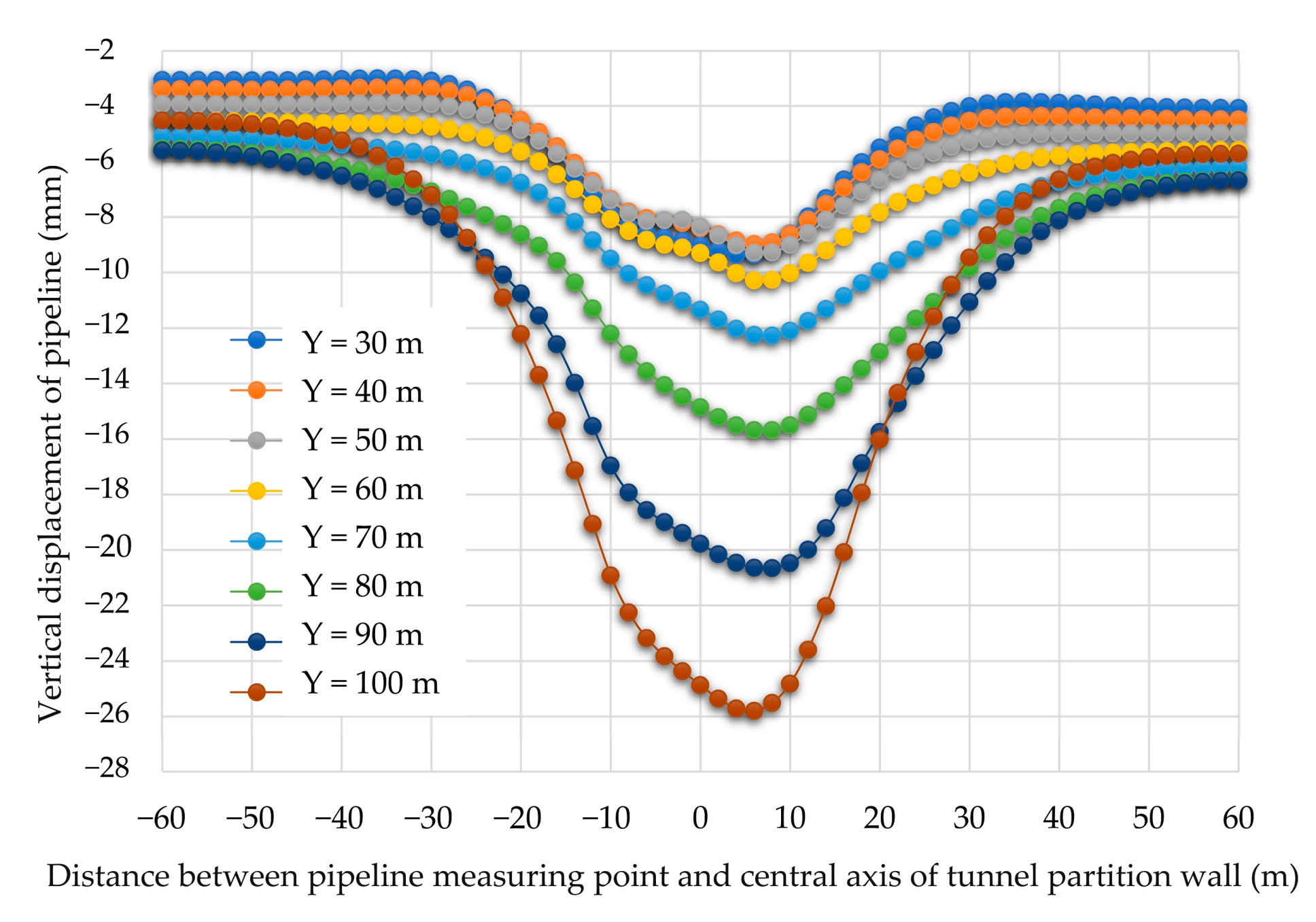
| Material | Density (kg/m3) | Elastic Modulus (MPa) | Poisson’s Ratio | Frictional Angle (°) | Cohesive Force (kPa) | Coefficient of Permeability (10−6 m·s) | Thickness (m) |
|---|---|---|---|---|---|---|---|
| Miscellaneous fill | 1510 | 10.76 | 0.32 | 19.4 | 26.8 | 52.52 | 2~13.46 |
| Completely weathered granite | 1630 | 13.00 | 0.35 | 23.4 | 49.4 | 63.00 | 10 |
| Strongly weathered Diabase | 1680 | 200.00 | 0.3 | 30.5 | 56.5 | 53.00 | 32 |
| Fault fracture zone | 1430 | 18.00 | 0.42 | 22.0 | 26.95 | 16.0 | 25 |
| Pipeline | 1400 | 2000 | 0.34 | — | — | — | 0.01 |
| Contact surfaces | — | Kn = 964.7 | Ks = 964.7 | 30.4 | 242 | — | — |
| The pilot tunnel lining | 2500 | 25,000 | 0.23 | — | — | — | 0.24 |
| Inverted arch initial support | 2600 | 34,000.00 | 0.15 | — | — | — | 0.3 |
| Partition | 2500 | 30,000.00 | 0.20 | — | — | — | — |
| Primary lining | 2600 | 34,000.00 | 0.15 | — | — | — | 0.3 |
| Secondary lining | 2550 | 32,000.00 | 0.15 | — | — | — | 0.22 |
Publisher’s Note: MDPI stays neutral with regard to jurisdictional claims in published maps and institutional affiliations. |
© 2021 by the authors. Licensee MDPI, Basel, Switzerland. This article is an open access article distributed under the terms and conditions of the Creative Commons Attribution (CC BY) license (https://creativecommons.org/licenses/by/4.0/).
Share and Cite
Wang, J.; Cao, A.; Wu, Z.; Sun, Z.; Lin, X.; Sun, L.; Liu, X.; Li, H.; Sun, Y. Numerical Simulation of Ultra-Shallow Buried Large-Span Double-Arch Tunnel Excavated under an Expressway. Appl. Sci. 2022, 12, 39. https://doi.org/10.3390/app12010039
Wang J, Cao A, Wu Z, Sun Z, Lin X, Sun L, Liu X, Li H, Sun Y. Numerical Simulation of Ultra-Shallow Buried Large-Span Double-Arch Tunnel Excavated under an Expressway. Applied Sciences. 2022; 12(1):39. https://doi.org/10.3390/app12010039
Chicago/Turabian StyleWang, Jianxiu, Ansheng Cao, Zhao Wu, Zhipeng Sun, Xiao Lin, Lei Sun, Xiaotian Liu, Huboqiang Li, and Yuanwei Sun. 2022. "Numerical Simulation of Ultra-Shallow Buried Large-Span Double-Arch Tunnel Excavated under an Expressway" Applied Sciences 12, no. 1: 39. https://doi.org/10.3390/app12010039
APA StyleWang, J., Cao, A., Wu, Z., Sun, Z., Lin, X., Sun, L., Liu, X., Li, H., & Sun, Y. (2022). Numerical Simulation of Ultra-Shallow Buried Large-Span Double-Arch Tunnel Excavated under an Expressway. Applied Sciences, 12(1), 39. https://doi.org/10.3390/app12010039








